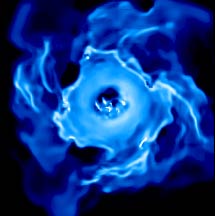
Handy Links
SLAC News Center
SLAC Today
- Subscribe
- Archives: Feb 2006-May 20, 2011
- Archives: May 23, 2011 and later
- Submit Feedback or Story Ideas
- About SLAC Today
SLAC News
Lab News
- Interactions
- Lightsources.org
- ILC NewsLine
- Int'l Science Grid This Week
- Fermilab Today
- Berkeley Lab News
- @brookhaven TODAY
- DOE Pulse
- CERN Courier
- DESY inForm
- US / LHC
SLAC Links
- Emergency
- Safety
- Policy Repository
- Site Entry Form

- Site Maps
- M & O Review
- Computing Status & Calendar
- SLAC Colloquium
- SLACspeak
- SLACspace
- SLAC Logo
- Café Menu
- Flea Market
- Web E-mail
- Marguerite Shuttle
- Discount Commuter Passes
-
Award Reporting Form
- SPIRES
- SciDoc
- Activity Groups
- Library
Stanford
Around the Bay
Computer Simulations of the Growth of Massive Black Holes
 In recent years, observations have given spectacular insights into the formation of black holes and galaxies. First, astronomers discovered that massive black holes exist in every galaxy observed to contain a spheroidal component. Second, the mass of those black holes correlates with both the mass and average random velocities of the stars in their host galaxies. These observed correlations suggest that black hole mass is intimately connected with galaxy formation.
In recent years, observations have given spectacular insights into the formation of black holes and galaxies. First, astronomers discovered that massive black holes exist in every galaxy observed to contain a spheroidal component. Second, the mass of those black holes correlates with both the mass and average random velocities of the stars in their host galaxies. These observed correlations suggest that black hole mass is intimately connected with galaxy formation.
There are two compelling theories to explain the observed correlations. In one theory, the black holes are formed first, and then regulate galaxy formation by producing huge amounts of radiation that pushes on the protogalactic gas. This pressure would prevent the continued formation of stars and thus determine the mass of the galaxy. In the other theory, the black holes and galaxies grow together. If, for example, 0.1% of the gas that makes stars always gets fed to the central black hole, then the black hole mass is always 0.1% of the mass of the host spheroid as observed. While the first theory is currently very popular in the astronomical community, there is no observational evidence of this type of outflow that would completely stop the formation of a galaxy. On the other hand, there is plenty of evidence that galaxies undergoing a burst of star formation also have plenty of "food" for black holes, encouraging the black hole's growth as in the second theory.
Three-dimensional numerical simulations performed on parallel computers at SLAC allowed KIPAC researchers to compute for the first time the feeding of black holes in a dense gaseous region that has an ongoing starburst, like those seen at the center of galaxies in formation (see above image).
These simulations are unique because they are the first with the resolution required to follow the transport of gas from galactic scales, down to the scales where the black holes dominate the dynamics and the gas forms an accretion disk around them. Preliminary results show that the black holes do grow together with the host galaxies, with a final mass surprisingly close to the mass expected from the observed correlations.
—Andrés Escala, April 5, 2007